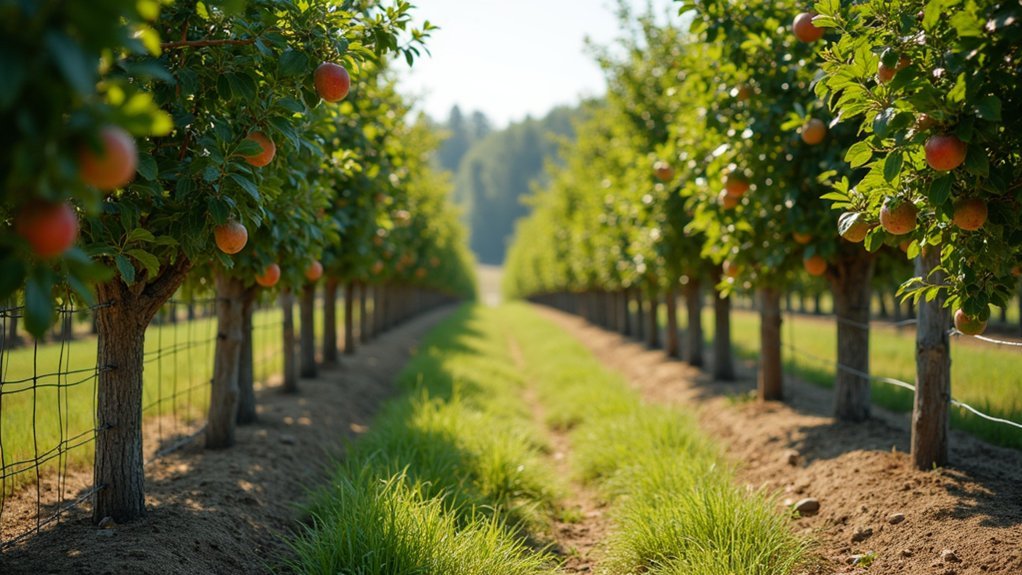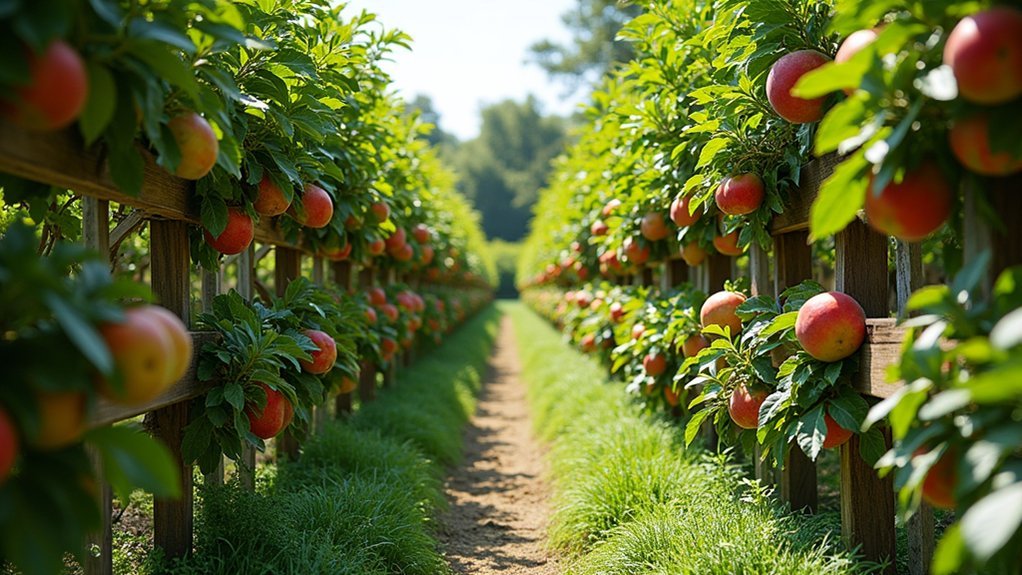Three simple horizontal cordon fence options for fruit trees include: a traditional wire and post system using redwood posts with eyebolts at 18, 36, and 54 inches; a DIY wooden frame with 4×4 posts and 2×4 horizontal rails; and multi-tier espalier designs that maximize space and yield. You’ll need sturdy posts spaced 8 feet apart, sunk at least 2 feet deep, with 12-gauge wire for support. These designs offer excellent sunlight exposure and easier harvesting while creating beautiful garden features.
Traditional Wire and Post System for Horizontal Cordon Training

When building a traditional wire and post system for horizontal cordon training, you’ll need sturdy 44-inch redwood posts placed 8 feet apart and sunk 2½ feet into the ground for proper stability.
Install eyebolts at heights of 18, 36, and 54 inches, allowing a 2-inch gap between posts and eyebolts to accommodate branch growth.
Thread 12-gauge training wires through these eyebolts and tighten with turnbuckles to create a robust framework for guiding your fruit trees. This system works excellently for apple trees, pear trees, and other suitable varieties trained against a wall or fence.
A strong wire framework becomes the backbone for beautiful espaliered fruit trees, guiding their growth with precision and purpose.
The horizontal cordon structure guarantees ideal sunlight exposure and improved air circulation, reducing disease risk while making harvest accessible without ladders.
It’s an ideal solution for maximizing space in small gardens.
DIY Wooden Frame Supports for Small-Space Orchards
Because space comes at a premium in many home gardens, DIY wooden frame supports offer an elegant solution for creating horizontal cordon systems in compact areas.
You’ll need 4×4 posts buried at least 2 feet deep, spaced 8 feet apart to properly support your espaliered trees.
Attach 2×4 horizontal rails at 18, 36, and 54 inches above ground, then thread 12-gauge wire through eyebolts on the posts to create durable branch supports.
This wooden frame structure provides ideal guidance for your fruit trees’ horizontal growth.
Select a well-drained, sunny location receiving at least 6 hours of daily sunlight for best fruit production.
Regular pruning maintains the classic cordon shape and makes certain your small-space orchard remains both productive and visually striking.
Multi-Tier Espalier Designs for Maximizing Yield in Narrow Gardens

While single-tier cordons offer simplicity, multi-tier espalier designs transform narrow gardens into remarkably productive fruit orchards. You’ll typically space each tier about 18 inches apart, creating ideal conditions for both sunlight exposure and air circulation.
| Tier Feature | Benefit |
|---|---|
| Horizontal growth | Develops productive fruiting spurs |
| 18″ vertical spacing | Maximizes light penetration |
| Dwarf tree varieties | Maintains manageable size |
| Strategic pruning | Maintains desired shape and vigor |
| Sunlight alignment | Increases overall yield potential |
For best results, select dwarf or semi-dwarf fruit trees that remain compact while delivering substantial harvests. Regular pruning encourages horizontal branch development across each tier. By properly positioning your multi-tier espalier to maximize sunlight exposure, you’ll create an efficient vertical growing system that dramatically increases fruit production in limited space.
Frequently Asked Questions
Is Cordon the Same as Espalier?
No, they’re not the same. Cordon is actually a specific type of espalier technique. You’ll find that while all cordons are espaliers, not all espaliers are cordons—espalier encompasses various training patterns.
What Not to Plant Next to Fruit Trees?
Don’t plant heavy feeders like corn or tomatoes, allelopathic plants like black walnut, invasive species like mint or bamboo, pest-attracting flowers, or plants with conflicting water needs near your fruit trees. They’ll compete for resources or harm growth.
What Fruit Trees Are Easiest to Espalier?
You’ll find apple trees, especially ‘Honeycrisp’ and ‘Liberty,’ easiest to espalier. Pear trees like ‘Kieffer,’ dwarf peach varieties, pomegranates, and ornamental crabapples also train well with their flexible branches and productive nature.
What Are the Disadvantages of Espalier Trees?
You’ll face time-intensive training and pruning, potential growth irregularities, increased pest vulnerability, root space limitations affecting tree health, and some varieties simply won’t adapt well to espalier techniques despite your best efforts.
In Summary
You’ll find that horizontal cordon fences offer elegant solutions for any garden size. Whether you choose traditional wire systems, build custom wooden frames, or create multi-tiered espaliers, you’re investing in both aesthetics and productivity. Don’t hesitate to adapt these designs to fit your unique space. With proper training and patience, your fruit trees will reward you with abundant harvests while enhancing your landscape’s visual appeal.





Leave a Reply